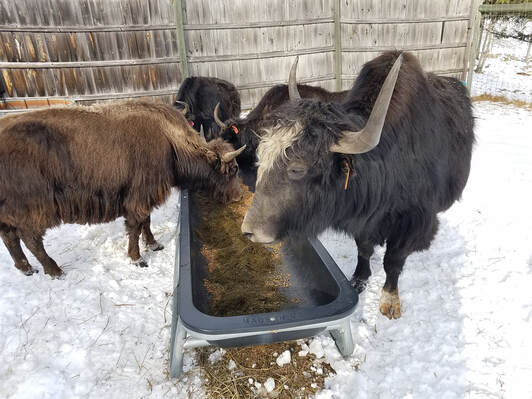|
You know what that is? That's homegrown winter feed that the stock have decided they love. It's grass clipping silage (aka haylage) that I ensiled (fermented into usable, storable feed) in garbage bags last April. I only put up three bags as an experiment this year, but now that I've spoken with my vet and let the critters try it, next year, I'm going whole hog! So what prompted this experiment, you might ask? This, my friends, is my front yard. And it's only a small portion of the yard that I mow each week, all growing season long. It takes me between 3 and 4 hours to mow with a very fast ZTR mower and, if the grass has grown so much that week that I have to bag it so it doesn't leave clumps everywhere, I will add between one and two cubic yards of grass clippings to my compost pile. Although the clippings don't go to waste, per se, as they either are composted in place or in my compost pile, as a stockman, it galls me. What a bunch of wasted feed! Every time I mow, all I can think is, "Dangnabit, someone could be eating this!" So I started doing research, and, low and behold, I found a very promising answer! The only experience I had with silage prior to this endeavor was smelling it as I drove by silage pits, but I came across a few articles that described being able to preserve grass on a small scale by putting it up in air tight bags. Interestingly, most of the research on this is as a method to help African farmers to withstand drought and seasonal fluctuations in forage availability. There are also a few outfits in the US trying to develop large scale methods of ensiling grass clippings as a way to reduce landscape waste, but I'm not sure how you account for spray residue in that kind of operation, where the clippings are coming a bunch of different residential lawns. Obviously, if I'm going to feed it to my animals, I want to be sure I'm not feeding them a bunch of herbicides and pesticides! The concept was so simple, I figured I had nothing to lose. One day in April while mowing, instead of dumping all the clippings in my compost pile, I simply dumped some of them into garbage bags, squished all the air out of them, and tied them up. I then put the bags in the back of my lawn shed and forgot about them... well, that's not completely true. Every time I went into the shed, I was reminded of them because I could smell them! But it wasn't really a bad smell, it was just really fermenty. About mid-summer, I opened one of the bags to take a peek and was thrilled to find perfectly fermented grass. I closed the bag up tightly again and then let them sit until last month. They held perfectly and looked just the same last month as they did in July. Amazing! After speaking with my vet to be sure I didn't need to have the forage tested before feeding it, I let the critters have a go. They were initially a bit unsure about it, but within a day, they were convinced that it was good eats! The yak love it. The elk love it. And next winter when I have laying hens, I'm sure they'll love it and I'll be able to enjoy dark, rich yolked eggs all winter long! I am so excited! I'm almost even excited to start mowing again. Almost.
4 Comments
John
5/21/2023 09:55:33 am
Hello
Reply
Tara @lightningtfarms
5/21/2023 11:28:15 am
Pretty well... The year after this post, I did like 30-40 bags, but there were a few issues with the bags, so I only did a few last year while I pondered a solution. The problem with the bags is that I have issues keeping them airtight (both due to challenges "sealing" them and challenges with mice chewing through), and so you end up with mold in the bag. Sometimes, that isn't a huge deal; sometimes, you can just lift the mold cap off and be good to go, but sometimes the whole bag is ruined. Between that issue and the fact that it bothers me that I can't reuse the bags. I thought I'd take a year and let my brain stew over it. Last fall, I had the brainstorm that maybe I could use 5 gallon buckets with lids, so I'm going to try that this year and see how it goes. I'll keep you updated!
Reply
Trev
11/27/2023 05:07:36 pm
I've started using my topper mower to cut long grass paddocks for ensiling rather than my reel mower as it handles very long grass better, ie I end up with fewer soldiers being flattened by the advance of the mower and staying uncut. The resulting more chopped greenstuff is then raked and baled as per normal, and it makes lovely dense crumbly forage that smells of fruit loaf. If you haven't got a baler you might try putting your clippings into a 200 litre blue plastic barrel with removable lid, really pressing the stuff down and then working out some way to evacuate the remaining air from the barrel once the lid is on to aid with the anaerobic bacterial ferment startup. Only just thought of this so haven't tried it yet; the one-way valve off those underbed storage bags could be easily adapted I imagine, and the barrels themselves are impervious to weather, rodents, mishandling, and able to be reused multiple times, plus they are cheap as chips from recyclers. Leave a Reply. |
Archives
January 2024
Categories
All
|



 RSS Feed
RSS Feed